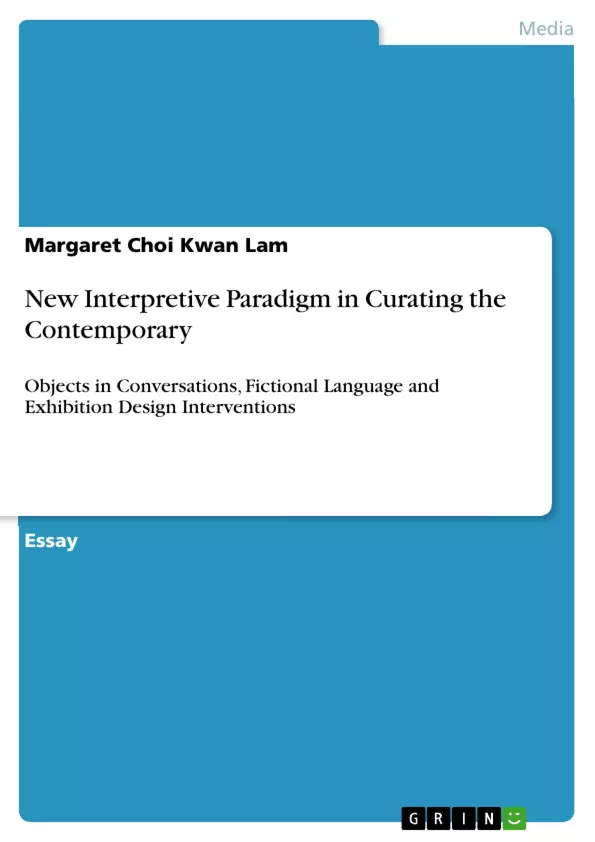Curating contemporary exhibitions is now more than a profession of connoisseurship, but rather a creative and artistic venture. Due to a paradigm shift in the heart of interpretive ideology, exhibition-making is going more experimental even in museum context. One might observe that there is a changing status in museum objects, and a progressive transformation in the exhibitionary language - shifting from descriptive to fictional, poetic and novelistic. Artworks are also functioning as text initiating dialogues, while exhibition designs are no longer merely fabrications, but becoming artistic interventions that could re-contextualize the experience of space. Unprecedentedly, curators nowadays could embrace huge potentials in creating imaginative narratives for the present time, and thus, to further produce innovative museum experiences. This essay aims to examine the changing attitudes and assumptions in the new interpretive paradigm. Through three case studies, it goes on to uncover the dynamic interpretive strategies undertaken which have created various unique curatorial voices. Cases include: The Surreal House (Barbican Art Gallery, 2010), David Bowie Is (V&A, 2013) and The Concise Dictionary of Dress (Blythe House, 2010).
Table of Contents
- Abstract
- Introduction
- Discussion
- Section 1
- A Critique on Conventional Interpretive Practices
- Museum Objects in Mausoleum and Fixed Interpretive Approach
- Section 2
- A Paradigm Shift in Contemporary Interpretations
- Art Objects as Text and New Poetic/ Fictional Language
- Exhibition Design as Artistic Intervention : Re-contextualize Experience of Space
- Section 3
- Case Study
- The Surreal House (Barbican Art Gallery, 2010)
- A Cross-disciplinary Narrative
- Labyrinth Space Design and Labyrinthine Aesthetic
- Novelistic Language and Artwork Dialogues: An Orchestration
- David Bowie Is (V&A, 2013)
- Narrating a Living Figure
- The Fictional Language - Open-ended-sentence Title
- Museum as Immersive Stage - Archive Comes to Life
- The Concise Dictionary of Dress (Blythe House, 2010)
- A Sartorial Interpretation in Fashion Reserve
- Poetic Exhibitionary Language
- Installation Designs as Artistic Interventions
- The Surreal House (Barbican Art Gallery, 2010)
- Case Study
- Section 1
Objectives and Key Themes
This essay aims to examine the changing attitudes and assumptions in the new interpretive paradigm in curating contemporary exhibitions. Through three case studies, it uncovers the dynamic interpretive strategies undertaken to create various unique curatorial voices.
- The shift from descriptive to fictional, poetic and novelistic exhibitionary language.
- Artworks as text initiating dialogues.
- Exhibition designs as artistic interventions.
- The potential for curators to create imaginative narratives for the present time.
- The changing status of museum objects.
Chapter Summaries
The introduction discusses the shifting focus of interpretative ideology in exhibition-making, highlighting a move from object-centered to experience-centered museum culture. It also introduces the three case studies that will be analyzed: The Surreal House, David Bowie Is, and The Concise Dictionary of Dress.
Section 1 critiques conventional interpretive practices, particularly the tendency for museum objects to be displayed in a fixed and static manner. This section also explores the limitations of a traditional mausoleum approach to curating.
Section 2 examines the paradigm shift in contemporary interpretations. This section explores the use of art objects as text and the emergence of new poetic and fictional language in exhibition design. It also discusses the role of exhibition design as an artistic intervention that can recontextualize the experience of space.
Section 3 presents the three case studies. The Surreal House case study examines a cross-disciplinary narrative, labyrinth space design, and the use of novelistic language and artwork dialogues. The David Bowie Is case study focuses on narrating a living figure, the use of open-ended sentence titles, and the museum as an immersive stage. Finally, the Concise Dictionary of Dress case study explores a sartorial interpretation in fashion reserve, poetic exhibitionary language, and installation designs as artistic interventions.
Keywords
This essay focuses on the new interpretive paradigm in curating contemporary exhibitions. Key themes include the use of art objects as text, the emergence of fictional and poetic language in exhibition design, and the role of exhibition design as an artistic intervention. The essay explores these themes through the lens of three case studies: The Surreal House, David Bowie Is, and The Concise Dictionary of Dress.
- Quote paper
- Margaret Choi Kwan Lam (Author), 2013, New Interpretive Paradigm in Curating the Contemporary, Munich, GRIN Verlag, https://www.grin.com/document/266357



